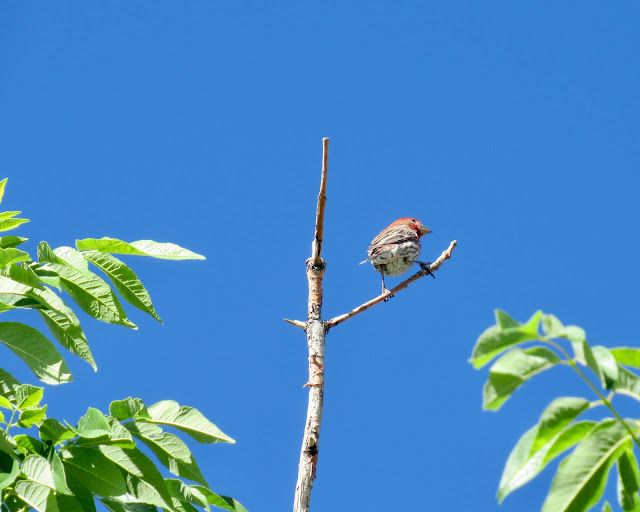I've been stepping out farther
this week into neighboring
Red-tailed Hawk Park.
Many people enjoy
its picnic area, playgrounds,
and sports facilities,
but I go for its boardwalk,
cottonwood stands,
and prairie dog colony.
Red-tailed Hawk Park
Aurora, Colorado, USA June 20, 2020
© M. Louise (MacBeath) Barbour/Fundy Blue
All Rights Reserved
Since I don't come from a Colorado ranching family, I love prairie dogs!
Red-tailed Hawk Park's noisy, energetic little critters are black-tailed prairie dogs
(Cynomys ludovicianus), and they have lived along the Front Range
for thousands and thousand of years. At one time their "towns" or colonies
covered as much as seven million acres in the eastern third of Colorado.
They typically live east of the foothills at elevations below 6000 feet (1828 meters).
Black-tailed Prairie Dog
Red-tailed Hawk Park
Aurora, Colorado, USA
June 20, 2020
© M. Louise (MacBeath) Barbour/Fundy Blue
All Rights Reserved
The black-tailed prairie dog is one of three species in Colorado,
and it can be identified by the black tip on its tail and where it lives in the state.
It's not very big, weighing one to three pounds (about a kilogram)
and reaching 14 to 17 inches (36 to 43 centimeters) in length.
The prairie dogs have tan fur tinged with reddish-brown,
short ears, large eyes, and a long, round head. These animals are rodents,
burrowing ground squirrels with sharp claws perfect for digging.
Black-tailed Prairie Dog
Red-tailed Hawk Park
Aurora, Colorado, USA
June 20, 2020
© M. Louise (MacBeath) Barbour/Fundy Blue
All Rights Reserved
Black-tailed prairie dogs are highly social animals,
and they live in large colonies of close knit family groups or coteries
consisting of a male, two or three females, and their pups.
They are active during the day and do not hibernate in the winter.
They dig extensive burrows underground
and mound the excavated dirt around the entrances to their burrows.
These mounds help to protect the burrows from flooding
and allow the prairie dogs to see approaching predators.
Typically the prairie dogs clip the plants around these mounds
to spot predators more easily.
Lots of predators hunt black-tailed prairie dogs:
coyotes, hawks, eagles, badgers, rattlesnakes, owls, bobcats, foxes, and ferrets.
Prairie Dog Town
Red-tailed Hawk Park
Aurora, Colorado, USA
June 20, 2020
Prairie dogs are very vocal. They have a complex system of communication
of yips, chirps, whistles, growls, and barks
that rivals the languages of chimps, dolphins, and orcas (Scientific American).
It's almost impossible to sneak up on a prairie dog.
They are constantly on the alert, and the moment one spots you,
its short, shrill barks ring out repeatedly.
Step a little closer, and the prairie dog dives into its burrow
and others farther away take up the alarm cry.
Their calls identify the type of predator and describe what it looks like.
Black-tailed Prairie Dog
Red-tailed Hawk Park
Aurora, Colorado, USA
June 20, 2020
© M. Louise (MacBeath) Barbour/Fundy Blue
All Rights Reserved
Prairie dogs eat grasses, leaves, stems, sedges, roots, forbs, and seeds.
They obtain water from plants such as the prickly pear cactus.
Prickly Pear Cactus
Red-tailed Hawk Park
Aurora, Colorado, USA
June 20, 2020
© M. Louise (MacBeath) Barbour/Fundy Blue
All Rights Reserved
Black-tailed prairie dogs are a keystone species in the short grass prairie.
They provide food for many predators, and their foraging and burrowing activities
increase the diversity of plants and animals in their area.
They overturn, aerate, and enrich the soil,
help to move rainwater down to the water table,
and encourage the growth of native grasses by clipping vegetation.
Over 150 species of birds and animals depend on
the food and shelter provided by prairie dog ecosystems.
Black-tailed Prairie Dog
Red-tailed Hawk Park
Aurora, Colorado, USA
June 20, 2020
© M. Louise (MacBeath) Barbour/Fundy Blue
All Rights Reserved
Black-tailed prairie dogs have decreased drastically in number
because of habitat destruction, poisoning and shooting, and the sylvatic plague.
It's unfortunate that many people don't appreciate the importance
of this animal to the health of the short grass prairie ecosystem.
Till next time ~
Fundy Blue
On the Bay of Fundy
© M. Louise (MacBeath) Barbour/Fundy Blue
All Rights Reserved
For Map Lovers Like Me:
Location of Aurora, Colorado, USA
Area Where I Took the Photographs
(by the asterisk in the lower middle)
Map Data © 2018 Google United States
Southern Aurora and Northern Parker
Map Data © 2019 Google United States
Adapted from a Sign in the Park
Red-Tailed Hawk Park
Aurora, Colorado, U.S.A.
© M. Louise (MacBeath) Barbour/Fundy Blue
All Rights Reserved














































